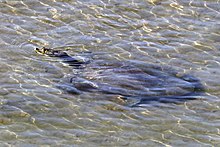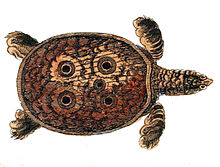Indian softshell turtle
| Indian softshell turtle | |
|---|---|

| |
| Babai River, Nepal | |

| |
| Immature (the dark eyespots on the carapace are indistinct or absent in adults)[1] | |
| Scientific classification | |
| Domain: | Eukaryota |
| Kingdom: | Animalia |
| Phylum: | Chordata |
| Class: | Reptilia |
| Order: | Testudines |
| Suborder: | Cryptodira |
| Family: | Trionychidae |
| Genus: | Nilssonia |
| Species: | N. gangetica
|
| Binomial name | |
| Nilssonia gangetica | |
| Synonyms[4] | |
| |
The Indian softshell turtle (Nilssonia gangetica), or Ganges softshell turtle is a species of softshell turtle. It lives in rivers such as the Ganges and Mahanadi in India and Bangladesh. Its shell can be up to 94 cm (37 in) in length.[1] It feeds mostly on fish, amphibians, carrion and other animal matter, but also eats aquatic plants.[1] The turtle is listed as a vulnerable species.[3]
The turtle has a long neck and a long nose, which means it is able to easily keep the tip of the nose out of the water to breathe.[5] It has an oval shaped shell, which is also fairly flat and smooth which means it is able to swim very fast.[5]
These turtles are often kept in the temple ponds of Odisha where they are considered sacred.[6]
The Indian softshell turtle is under threat as 30 to 40 tons of turtle meat is sold in markets every week.[5] The shells are also used to make masks, which are sold to tourists.[5] The turtles' habitat is also being changed by the building of dams, drainage works, and increasing levels of fishing and farming.[5]
References[change | change source]
- ↑ 1.0 1.1 1.2 Ernst, C.H.; Altenburg, R.G.M.; and Barbour, R.W. (1997). Aspideretes gangeticus Archived 2016-03-04 at the Wayback Machine, Turtles of the World. Retrieved 17 June 2014.
- ↑ 2.0 2.1 Rhodin 2011, p. 000.207
- ↑ 3.0 3.1 3.2 Nilssonia gangetica from the Redlist
- ↑ Fritz Uwe; Peter Havaš (2007). "Checklist of Chelonians of the World" (PDF). Vertebrate Zoology. 57 (2): 310. ISSN 1864-5755. Archived from the original (PDF) on 17 December 2010. Retrieved 29 May 2012.
- ↑ 5.0 5.1 5.2 5.3 5.4 Nilssonia gangetica | ARKive: Ganges soft-shelled turtle videos, photos and facts - Nilssonia gangetica | ARKive Archived 2016-03-04 at the Wayback Machine, accessdate: December 21, 2015
- ↑ Annandale, Nelson; Shastri, Mahamahopadhyaya Haraprasad (1914). "Relics of the worship of mud-turtles (Trionychidae) in India and Burma". Journal of the Asiatic Society of Bengal: 131–138.

